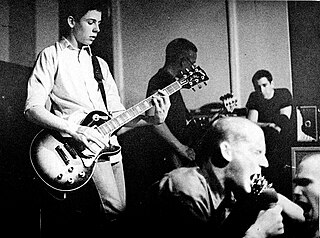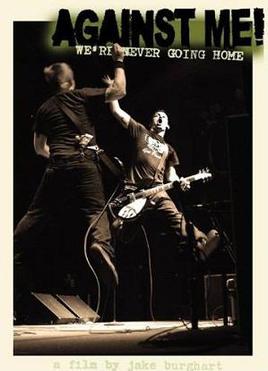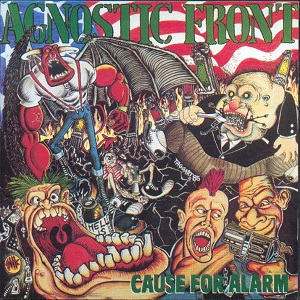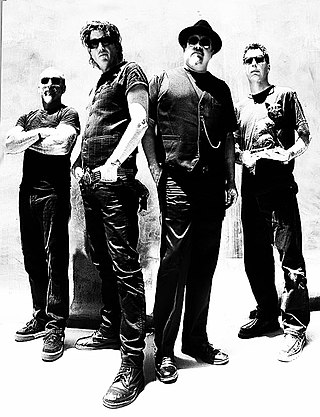Edward Colver | |
|---|---|
| Born | Edward Curtiss Colver June 17, 1949 Pomona, California, U.S. [1] |
| Occupation | Photographer |
| Years active | 1978–present [2] |
| Spouse | Karin Swinney [1] |
| Website | edwardcolver |
Edward Curtiss Colver (born June 17, 1949) is an American photographer, best known for his early punk photographs. [3] [4]
Colver not only created a visual document of the birth of the hardcore punk in suburban Southern California from late 1978 to mid-1984, but also he greatly helped in defining the photography style and graphic identity of the American hardcore punk movement. [2] [3]
He was actually in the right place at the right time, and with the right attitude, but he was not merely a witness in the eye of the storm, he was indeed a living part of that big picture, and in this regard, his early work is an authentic self-portrait of the Southern California hardcore punk scene in its golden years.
His work was featured extensively in the book American Hardcore: A Tribal History (2001), written by Steven Blush, and in its documentary film version, American Hardcore (2006), directed by Paul Rachman. [3]
A third-generation Southern Californian born on June 17, 1949, in Pomona, California, Colver was named after an ancestor who arrived in the United States from Cornwall, England, in 1635. [5] Edward's father, Charles Colver, was a forest ranger for 43 years. Upon his retirement, Charles was presented with the Theodore Roosevelt Conservation Award by President George H. W. Bush at the White House. The tallest peak southwest of Mount San Antonio aka Mount Baldy, was named Colver Peak after Charles. [1]
Essentially a self-taught photographer, [2] Colver had a brief formal training during night classes at University of California, Los Angeles, where he studied beginning photography with Eileen Cowin. Largely influenced by Dada and Surrealism, Colver was most impressed in his early years by the art of Southern Californian native Edward Kienholz. In the late 1960s, Edward's perspective on life and art was changed by his exposure to composers such as Edgard Varèse, Karlheinz Stockhausen, Krzysztof Penderecki and John Cage. [1]
Three months after he began taking photographs, Colver had his first photograph published: an image of performance artist Johanna Went, featured in BAM magazine. Since then he has shot photographs for dozens of record labels including EMI, Capitol and Geffen. His pictures have been featured on more than 500 album covers and include some of the most recognizable and iconic covers of the punk era. [1]
| Year | Album title | Artist | Contribution |
|---|---|---|---|
| 1980 | Group Sex | Circle Jerks | front, back cover and inner sleeve photos [6] |
| 1981 | "Louie Louie" (single) | Black Flag | front and back cover photos [7] |
| 1981 | Damaged | Black Flag | front cover photo |
| 1981 | Danger Zone (EP) | China White | front cover photo |
| 1981 | Let Them Eat Jellybeans! | various artists | back cover photo [8] |
| 1981 | Reagan's In | Wasted Youth | back cover and insert sheet photos [9] |
| 1981 | T.S.O.L. (EP) | T.S.O.L. | front cover photo |
| 1981 | Dance with Me | T.S.O.L. | some inner sleeve photos [10] |
| 1981 | Welcome to Reality (EP) | Adolescents | front cover photo [11] |
| 1982 | How Could Hell Be Any Worse? | Bad Religion | front cover and some insert sheet photos [12] |
| 1983 | Mommy's Little Monster | Social Distortion | back cover photo [13] |
| 1983 | L'amour | Lewis | front cover photo [14] |
| 2019 | Submit to the Blade | The Balboas | back cover photo |

Hardcore punk is a punk rock subgenre and subculture that originated in the late 1970s. It is generally faster, harder, and more aggressive than other forms of punk rock. Its roots can be traced to earlier punk scenes in San Francisco and Southern California which arose as a reaction against the still predominant hippie cultural climate of the time. It was also inspired by Washington, D.C., and New York punk rock and early proto-punk. Hardcore punk generally disavows commercialism, the established music industry and "anything similar to the characteristics of mainstream rock" and often addresses social and political topics with "confrontational, politically charged lyrics".

Black Flag is an American punk rock band formed in 1976 in Hermosa Beach, California. Initially called Panic, the band was established by Greg Ginn, the guitarist, primary songwriter, and sole continuous member through multiple personnel changes in the band. They are widely considered to be one of the first hardcore punk bands, as well as one of the pioneers of post-hardcore. After breaking up in 1986, Black Flag reunited in 2003 and again in 2013. The second reunion lasted well over a year, during which they released their first studio album in nearly three decades, What The... (2013). The band announced their third reunion in January 2019.

Milo Goes to College is the debut studio album by the American punk rock band Descendents, released on September 4, 1982 through New Alliance Records. Its title refers to singer Milo Aukerman's decision to leave the band to attend college, and its cover illustration introduced a caricature of him that would go on to become the band's mascot. Milo Goes To College was Descendents' last record with founding guitarist Frank Navetta, who quit the band during the hiatus that followed its release.

Government Issue was an American hardcore punk band from Washington, D.C. active from 1980 to 1989. The band experienced many changes in membership during its nine-year existence, with singer John Stabb as the only consistent member in an ever-fluctuating lineup that at various times included notable musicians Brian Baker, Mike Fellows, Steve Hansgen, J. Robbins, and Peter Moffett. Government Issue originated from the Washington, D.C. hardcore scene but added elements of heavy metal, new wave, and psychedelic rock on later records. Though this has caused the band to be sometimes overlooked in relation to other Washington, D.C. hardcore acts, their stylistic diversity made them influential to later punk rock groups. Government Issue performed occasional reunion shows in the 2000s and 2010s with various lineups, until Stabb's death from stomach cancer in 2016.
Wasted Youth was an early 1980s hardcore punk band from Los Angeles, California. The band followed in the footsteps of Black Flag and the Circle Jerks. It was a prominent and popular act among the Los Angeles punk underground. Other bands active in the early 1980s Los Angeles punk scene were The Adolescents, T.S.O.L., Social Distortion, Bad Religion, Agent Orange, and The Stains.

This Is Boston, Not L.A. is a hardcore punk compilation released in 1982. It is considered the definitive album from the Boston hardcore scene, as several of its most prominent bands appear on the record, namely, Jerry's Kids, the Proletariat, the Groinoids, the F.U.'s, Gang Green, Decadence, and the Freeze. For them, with the exception of the latter, This Is Boston, Not L.A. was also their debut release. Al Barile's band, SSD, were asked to contribute, but they refused to participate.

Group Sex is the debut studio album by American hardcore punk band Circle Jerks. It was released on October 1, 1980, by Frontier Records. The album consists of 14 songs in 15 minutes and is considered to be a landmark album in hardcore punk. It was included in the book 1001 Albums You Must Hear Before You Die.

"We're Never Going Home" is the first DVD release of the Gainesville, Florida folk punk band Against Me!, produced by Jake Burghart and presented by Fat Wreck Chords. The feature presentation of the DVD follows the band on their United States tour that spanned from April 1 to May 2 of 2004 and also featured the hardcore punk band Planes Mistaken for Stars and the punk band No Choice.

Dance with Me is the first full-length album by the American hardcore punk band T.S.O.L., released in 1981 though Frontier Records. While the band's eponymously titled debut EP, released earlier that year, had been filled with radical leftist lyrics, Dance with Me moved away from politics in favor of horror film- and gothic-inspired subject matter. The album includes T.S.O.L.'s most well-known song, the necrophilia-themed "Code Blue". Following the punk rock revival of the 1990s, Dance with Me was re-released by Epitaph Records in 1996 and by Nitro Records in 2007.

American Hardcore: The History of American Punk Rock 1980–1986 is a documentary directed and produced by Paul Rachman and written by Steven Blush. It is based on the 2001 book American Hardcore: A Tribal History also written by Blush. It world premiered at the 2006 Sundance Film Festival and was released on September 22, 2006 on a limited basis by Sony Pictures Classics. The film features some early pioneers of the hardcore punk music scene including Bad Brains, Black Flag, D.O.A., Minor Threat, Minutemen, SSD, and others. It was released on DVD by Sony Pictures Home Entertainment on February 20, 2007.

China White was an influential hardcore punk band from Huntington Beach, California, best known for their EP Danger Zone. They were, along with The Crowd, Adolescents, Social Distortion, T.S.O.L. and Shattered Faith, the prominent figures of the early Orange County punk scene. In 1982, photographer Glen E. Friedman wrote: "Full doses of China White will send staggering chills through your veins as you experience this nitro-punk injection."

Cause for Alarm is the second full-length studio album by New York hardcore band Agnostic Front. It was released in 1986 on Relativity/Combat Records and follows 1984's Victim in Pain. The album is still available on a split release with Victim in Pain on the same disc.

American Hardcore: A Tribal History is a book written by Steven Blush that relates the history of the hardcore punk movement that took place in Northern America between 1980 and 1986. It was first published by Feral House in October 2001.

Dennis Morris is a British photographer, best known for his images of Bob Marley and the Sex Pistols.

T.S.O.L. is the eponymously titled debut EP by the American hardcore punk band T.S.O.L., released in 1981 through Posh Boy Records. Its fast tempos and politically radical lyrics established the band as a major force in the southern California hardcore scene of the time. T.S.O.L. quickly moved away from leftist political subject matter, however, shifting in a gothic rock direction and changing labels to Frontier Records for their full-length album Dance with Me (1981). This led to a dispute with Posh Boy owner Robbie Fields, who claimed the band owed his label another EP. The two parties eventually reached a settlement in which Posh Boy gained the rights to T.S.O.L.'s 1982 EP Weathered Statues, combining it with the debut EP in the 1987 compilation album Thoughts of Yesterday: 1981–1982. Nitro Records purchased the master recordings from Posh Boy in 1997 and re-released the two EPs as the compilation T.S.O.L. / Weathered Statues.

Live '91 is a live album by the American hardcore punk band T.S.O.L., released in 1991 through Triple X Records. It marked a reunion of the band's original lineup of singer Jack Grisham, guitarist Ron Emory, bassist Mike Roche, and drummer Todd Barnes. At the time, the rights to the name "T.S.O.L." were held by Joe Wood and Mitch Dean, who had replaced Grisham and Barnes in 1984 and taken the band in a glam metal direction. Wood legally prevented the original members from using the name for their reunion, so they were billed by their four full names and Live '91 does not carry the name T.S.O.L. on its packaging.

Symbol Six is an American rock and roll band formed in Santa Monica, California, United States, in 1980 by Eric Leach, Phil George, Mark Conway, Donny Brook, Taz Rudd, and Steve Cooper. Originating in Los Angeles and Orange County, when the band started the average age of the band members was 15 years old. The band has played clubs such as the Cuckoo's Nest, Godzillas, and Bards Apollo. Symbol Six has played with Social Distortion, Bad Religion, T.S.O.L., 45 Grave, Youth Brigade, Descendents, RF7 and Agent Orange.

Colourmeinkindness is the second studio album by English rock band Basement, released on 23 October 2012 by Run for Cover Records.

Danger Zone is the debut EP by the American hardcore punk band China White.
Steven Blush is an American author, journalist, record collector and film maker who is best known for his book American Hardcore and the movie of the same name. Blush has written five books, is the founder of Seconds magazine and has written articles for many magazines. Two of his books have been made into movies. Blush's work mainly specializes in hardcore punk music.